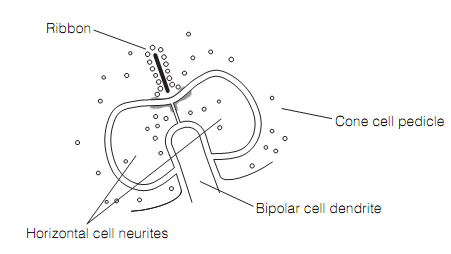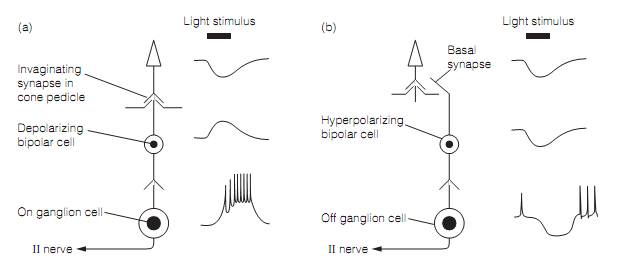Bipolar cells and on and off channels
The Photoreceptors synapse with bipolar cells. The two kinds of bipolar cell can be distinguished on the basis of both morphology and physiological responses. Those with procedures that form triad ribbon synapses shown in figure deep in the photoreceptor terminal are invaginating bipolar cells and they depolarize in response to light striking the photoreceptor. The triad ribbon synapses are so called as they have three postsynaptic components, the bipolar cell dendrite and dendrites of the two horizontal cells. By contrast, the flat bipolar cells form superficial basal synapses with photoreceptors and hyperpolarize in response to the light.

Figure: A triad ribbon synapse.
Cone cells form the synapses with midget bipolar cells (so called since of their size) of either one or another type. The midget bipolar cells synapse directly with ganglion cells that respond to light in similar sense as their bipolar cells. This arrangement gives mount to two labeled lines: on channels are created by cone-depolarizing bipolar cells (on ganglion cells), while off channels are cone-hyperpolarizing bipolar cells (off ganglion cells). The On ganglion cells are depolarized and increase their firing rate as a function of the light intensity. Off ganglion cells are silenced by the hyperpolarization as shown in figure.

Figure: (a) On channel and (b) off channel in the retina. In each situation electrophysiological responses of the cells to light stimulation recorded intra cellularly is shown on the right. All cells depict the use of glutamate as a neurotransmitter.
All the photoreceptors use glutamate as a transmitter. The reverse responses of invaginating and flat bipolar cells come about as they have distinct glutamate receptors. For invaginating bipolar cells, the tonic discharge of glutamate from photoreceptors in the dark is inhibitory. Whenever light hyperpolarizes the photoreceptor glutamate discharge is suppressed, and inhibition lifted, therefore the bipolar cell depolarizes. For flat bipolar cells the answer to tonic glutamate discharge is excitatory and light, by decreasing that excitation, cause the bipolar cell to hyperpolarize.
On channels respond with increased firing to light levels which are greater than the local average. The Off channels show increased firing in response to dark areas, that is, where light levels are lower than the local average. In this manner the existence of individual on and off channels is a mechanism to enhance the boundaries among areas which reflect different amounts of light. It is one of several procedures by which the visual system is adapted to respond preferentially to stimulus change as opposed to steady-state stimulation.